
Holy Family with the Infant Saint John the Baptist is a small (26.5 cm by 21 cm) oil on canvas painting, attributed to Correggio and dating to around 1514. It is now in the Los Angeles County Museum of Art, where it has been since 1946. [1] [2]

Holy Family with the Infant Saint John the Baptist is a small (26.5 cm by 21 cm) oil on canvas painting, attributed to Correggio and dating to around 1514. It is now in the Los Angeles County Museum of Art, where it has been since 1946. [1] [2]
It first became known to critics early in the 20th century and was lent to the Fogg Art Museum in 1905 or 1906, where it was seen and studied by Bernard Berenson, who published his work on it in 1907. His attribution of it to Correggio was supported by Adolfo Venturi and then in the 1970s by Arturo Carlo Quintavalle and Cecil Gould. David Alan Brown disagreed, thinking it an exercise in imitation of Correggio by Francesco Maria Rondani, a painter from Parma. In more recent years David Ekserdjian has doubted the attribution to Correggio, though it has been supported by Mario Di Giampaolo and Andrea Muzzi. [3]

Antonio Allegri da Correggio, usually known as just Correggio was an Italian Renaissance painter who was the foremost painter of the Parma school of the High Italian Renaissance, who was responsible for some of the most vigorous and sensuous works of the sixteenth century. In his use of dynamic composition, illusionistic perspective and dramatic foreshortening, Correggio prefigured the Baroque art of the seventeenth century and the Rococo art of the eighteenth century. He is considered a master of chiaroscuro.
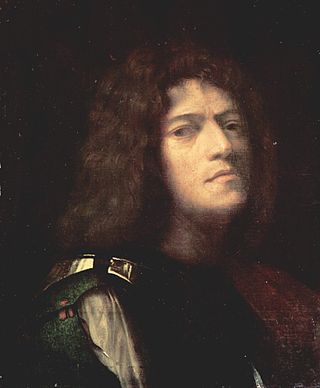
Giorgione was an Italian painter of the Venetian school during the High Renaissance, who died in his thirties. He is known for the elusive poetic quality of his work, though only about six surviving paintings are firmly attributed to him. The uncertainty surrounding the identity and meaning of his work has made Giorgione one of the most mysterious figures in European art.

Andrea Mantegna was an Italian painter, a student of Roman archeology, and son-in-law of Jacopo Bellini.

Giovanni di Niccolò de Luteri, better known as Dosso Dossi, was an Italian Renaissance painter who belonged to the School of Ferrara, painting in a style mainly influenced by Venetian painting, in particular Giorgione and early Titian.
Andrea Solari (1460–1524) was an Italian Renaissance painter of the Milanese school. He was initially named Andre del Gobbo, but more confusingly as Andrea del Bartolo a name shared with two other Italian painters, the 14th-century Siennese Andrea di Bartolo, and the 15th-century Florentine Andrea di Bartolo.

Girolamo Francesco Maria Mazzola, also known as Francesco Mazzola or, more commonly, as Parmigianino, was an Italian Mannerist painter and printmaker active in Florence, Rome, Bologna, and his native city of Parma. His work is characterized by a "refined sensuality" and often elongation of forms and includes Vision of Saint Jerome (1527) and the iconic if somewhat anomalous Madonna with the Long Neck (1534), and he remains the best known artist of the first generation whose whole careers fall into the Mannerist period.

The Pinacoteca del Castello Sforzesco is an art gallery in the museum complex of the Castello Sforzesco in Milan, northern Italy.

The Camera di San Paolo or Camera della Badessa is a room in the former Monastery of San Paolo, in Parma, northern Italy. It is painted with frescoes by Correggio in the vault (697x645 cm) and over the fireplace.

Venus with Mercury and Cupid, The School of Love or The Education of Cupid is a c. 1525 painting by the Italian painter Correggio, now in the National Gallery. It depicts the deities Cupid, Mercury, and Venus.

The Barrymore Madonna is a 1508–1510 painting by the Italian Renaissance artist Antonio da Correggio.

The Campori Madonna is an oil-on-panel painting executed ca. 1517–18 by the Italian Renaissance painter Antonio da Correggio.

The Allegory of Vice is an oil on canvas painting by Correggio dating to around 1531 and measuring 149 cm (59 in) by 88 cm (35 in).

The San Sebastiano Madonna is an oil-on-canvas painting by the Italian Renaissance master Correggio, dating to around 1524 and now in the Gemäldegalerie Alte Meister in Dresden. It measures 265 by 161 cm.
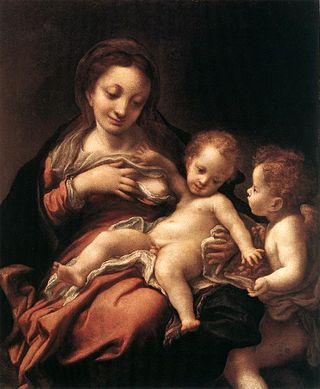
Nursing Madonna with an Angel is an oil painting on panel by Correggio, painted around 1524 and now in the Museum of Fine Arts in Budapest. It measures 68.5 by 87 cm and belongs to the Nursing Madonna or Madonna Lactans genre.

Holy Family with Saints Elizabeth and John the Baptist is an oil on panel painting, dating to around 1510, sometimes attributed to Correggio. It measures 28 by 21.5 cm and is now in the Pinacoteca Malaspina in Pavia.

The Holy Family with Saint Jerome is a 68 by 56 cm oil on poplar panel painting by Correggio. It dates to around 1515 and is now displayed in the East Closet of Hampton Court Palace as part of the Royal Collection. It has similarities with the Holy Family with the Infant Saint John the Baptist and so it probably dates to around the time Correggio painted the frescoes in the Camera di San Paolo or possibly slightly earlier. It shows the Holy Family and saint Jerome.
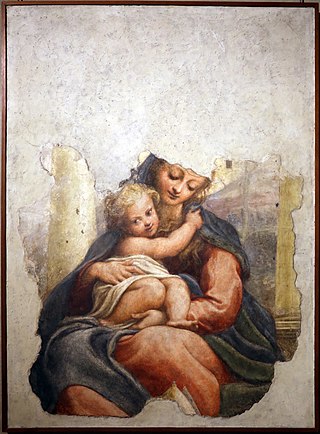
The Madonna of the Stairs is a fresco fragment by the Italian Renaissance artist Correggio, dating to ca.1522–23 and now in the Galleria Nazionale di Parma.

The Annunciation is a 157 by 315 cm fresco fragment by Correggio, dating to around 1524-1525 and now in the Galleria nazionale di Parma.
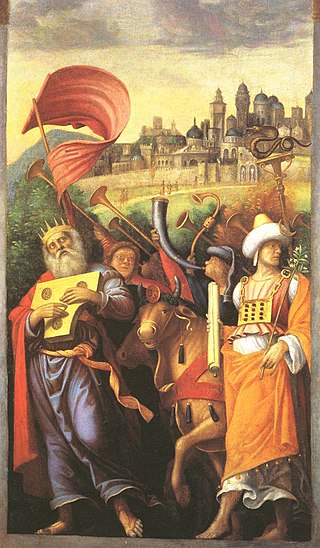
David Before the Ark of the Covenant is a c.1515 oil on canvas painting of King David by Correggio, rediscovered as a work by that artist by Giovanni Romano in 1996, an attribution accepted soon afterwards by David Ekserdjian. It is now in a private collection in Turin.
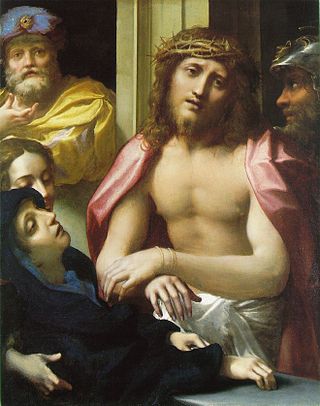
Ecce Homo, also known as Christ Presented to the People, is an oil painting by Antonio da Correggio. It is the last of the surviving pictures of the Passion of Jesus that Correggio executed during the 1520s. The painting is in the National Gallery, London.